Coppertip, also known as Crocosmia, Falling Stars, or Montbretia, belongs to the Iridaceae family and originates from regions spanning Sudan to southern Africa and Madagascar. This perennial flowering plant grows from bulbs and thrives in USDA hardiness zones 6 through 9.
Known for its striking red and orange blooms, Coppertip adds a bold splash of color to any garden. The plant’s dried leaves emit a unique, saffron-like aroma when placed in water, a characteristic that inspired its botanical name, derived from the Greek words for “saffron” and “odor.”
Ideal for gardeners seeking low-maintenance beauty, this bulbous plant is a reliable choice for brightening flower beds and borders. Its unique features make it a cherished addition to gardens, offering both visual appeal and intriguing sensory qualities.
| Common name | Coppertip, Crocosmia, Falling Stars, Montbretia |
| Botanical name | Crocosmia |
| Family | Iridaceae |
| Origin | Sudan to S. Africa and Madagascar |
| Life cycle | Bulb |
| Plant type | Bulb |
| Hardiness zone | 6, 7, 8, 9 |
| Sunlight | Full Sun |
| Maintenance | Low |
| Soil condition | High Organic Matter |
| Soil ph | Neutral |
| Drainage | Well-Drained |
| Growth rate | Medium |
| Spacing | Less than 12 in. |
| Harvest time | Fall |
| Flowering period | Summer |
| Height | 2 ft. – 3 ft. |
| Flower color | Gold, Yellow |
| Leaf color | Green |
| Leaf benefit | Showy |
| Flower benefit | Fragrant |
| Garden style | Butterfly Garden |
| Uses | Container |
I. Appearance and Characteristics
Crocosmia, also known as montbretia (), is a small genus of flowering plants in the iris family, Iridaceae. It is native to the grasslands of southern and eastern Africa, ranging from South Africa to Sudan. One species is endemic to Madagascar.
They can be evergreen or deciduous perennials that grow from basal underground corms. The alternate leaves are cauline and ensiform (sword shaped). The blades are parallel-veined. The margin is entire. The corms form in vertical chains with the youngest at the top and oldest and largest buried most deeply in the soil.
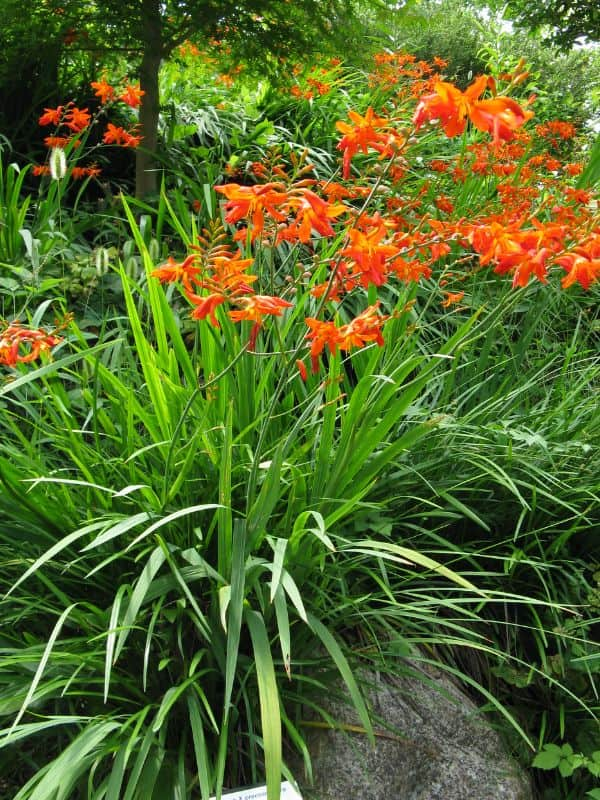
The roots of the lowermost corm in a chain are contractile roots and drag the corm deeper into the ground where conditions allow. The chains of corms are fragile and easily separated, a quality that has enabled some species to become invasive and difficult to control in the garden.
They have colourful inflorescences of 4 to 20 vivid red and orange subopposite flowers on a divaricately (horizontally) branched stem. The terminal inflorescence can have the form of a cyme or a raceme. These flower from early summer well into fall. The flowers are sessile on a flexuose arched spike. The fertile flowers are hermaphroditic. All stamens have an equal length. The style branches are apically forked. They are pollinated by insects, birds (sunbirds) or by the wind. The dehiscent capsules are shorter than they are wide.
The genus name is derived from the Greek words krokos, meaning “saffron”, and osme, meaning “odor” – from the dried leaves emitting a strong smell like that of saffron (a spice derived from Crocus – another genus belonging to the Iridaceae) – when immersed in hot water.
The alternative name montbretia is still widely used, especially for the garden hybrid C. × crocosmiiflora. “Montbretia” commonly used in the British Isles for orange-flowered C. × crocosmiiflora cultivars that have naturalised, while “crocosmia” is reserved for less aggressive red-flowered cultivars. Montebretia is a heterotypic synonym of the genus Tritonia in which some species of Crocosmia were once included. It was named by Alire Raffeneau Delile for Ernest Coquebert de Montbret, a fellow French botanist on Napoleon’s Egyptian Campaign.
II. How to Grow and Care
Sunlight
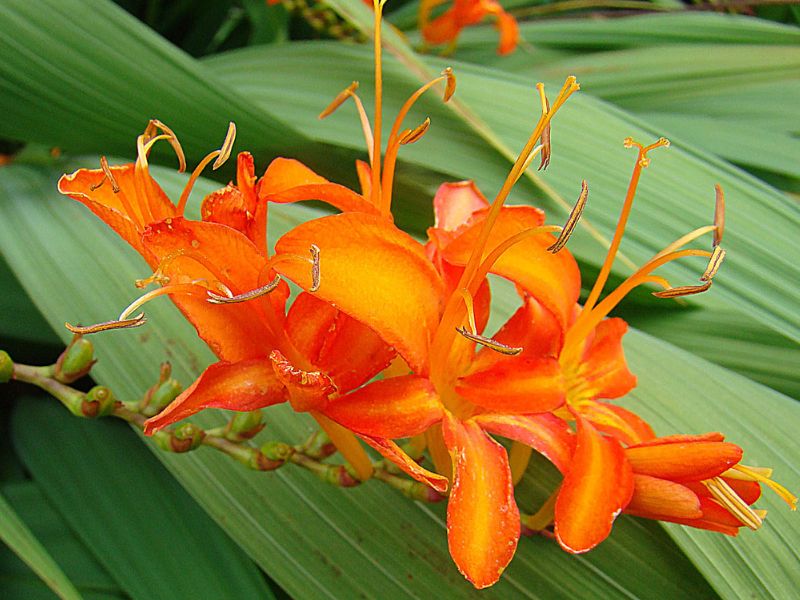
Crocosmia grows and flowers best in full sun. They will grow in partial sun conditions but won’t flower as much as they do when planted in full sun. Some afternoon shade is fine in hot climates. If your partially shaded plants are reaching toward the sun, dig up the corms once the foliage has faded and relocate them to a sunnier location.
Temperature and Humidity
Although crocosmia tolerates high heat and humidity, it thrives in drier climates with mild temperatures. Perhaps too much of a good thing isn’t desirable, according to gardeners in places like the Pacific Northwest, where these plants tend to take over the flowerbed.
Watering
Crocosmia plants need regular watering, but you should not overwater them or root rot could occur. Water only when the top of the soil feels dry.
Soil
Crocosmia plants don’t need to be pampered when it comes to soil, but good drainage is important. If your soil is composed of heavy clay, amend the soil with sand and peat moss to create a well-drained, loose consistency. The alternative is to grow crocosmia plants in raised beds or containers.
Fertilizing
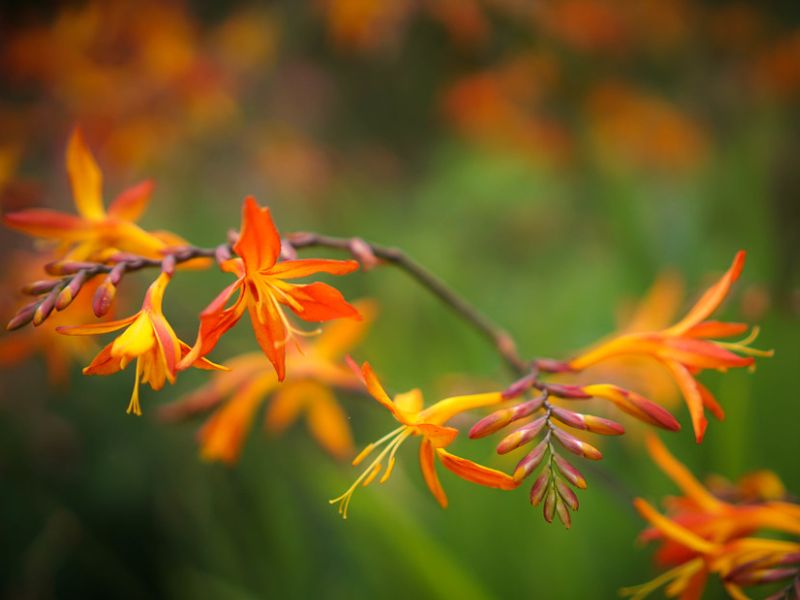
Crocosmia grows well in lean or rocky soils and doesn’t need supplemental fertilizer. Excessive nutrients can cause an overgrowth of foliage at the expense of the blooms.
Pruning
Cut down spent flower stalks, but don’t remove crocosmia foliage until it dies back naturally at the end of the growing season and when it turns light brown. While it is still green, the foliage photosynthesizes energy back into the corms to produce next year’s blooms.
Propagation
You can propagate crocosmia by removing the small offsets that form on the corms and planting them in a couple of easy steps. This division process not only yields more flowers but also increases the overall vigor of the plants because they can become crowded as do their cousins in the iris family.
- Dig the corms in the spring just before new growth starts.
- Separate the corms by hand.
- Replant them 6 to 8 inches apart.
How to Grow From Seed
- Collect seeds from the seed capsules that form up and down the flowering spike in the fall. The capsules will easily break apart with your fingers.
- Save seeds in seed packets until spring and place packets in a cool, dry, dark area that consistently stays under 60 degrees Fahrenheit.
- In the spring, nick them and soak them in water to help speed germination.
- Plant seeds in the ground in sandy loam after all chances of frost have passed.
Potting and Repotting
Any commercial potting soil will do for your crocosmia. Plant the corms closely in a container of any material and with drainage holes and watch for the grassy foliage to emerge a few weeks after planting. If no blooms occur in the first season, your corms may be too small to flower, so leave them growing in place until the next season.
Overwintering
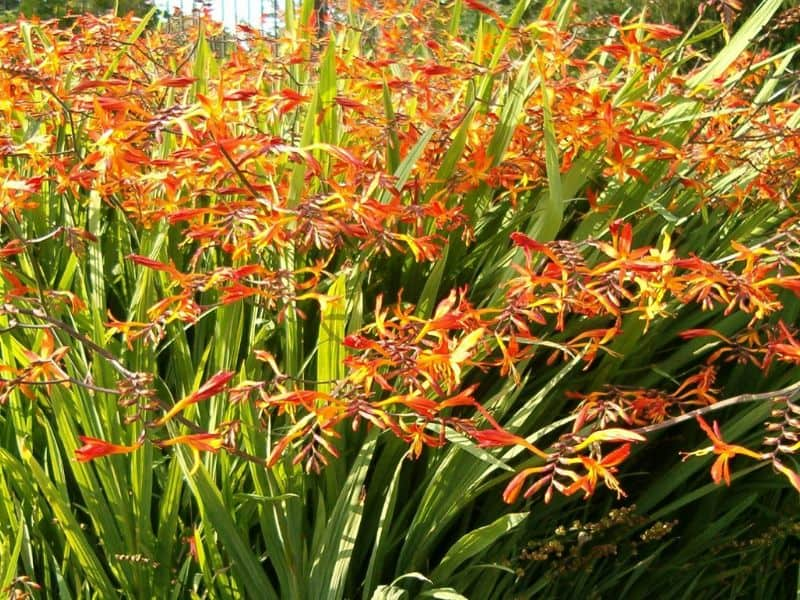
In their typical growing zones, crocosmia can be left in the ground for overwintering. A layer of mulch might help with peace of mind. In colder areas, dig up the corms and take them inside for storage in a cool, dry place during the winter months.
Pests and Diseases
Common Pests and Plant Diseases
Crocosmia is generally disease-free except for cases where there is poor drainage that leads to root rot. However, spider mites can plague crocosmia plants, especially when dry conditions prevail.
Common Problems
This flower is typically low-maintenance. You may find a couple of problems to contend with. Watch for these signs.
Mottled Leaves
If you notice that the leaves of your crocosmia flowers are mottled, pale, or covered in a web-like material, there could be a spider mite infestation. To confirm, look at the underside of a leaf with a magnifying glass to find the pest and eggs. The mites are sucking sap from the leaves which gives it that appearance. Eliminate mites with insecticidal soap, neem oil, or use pesticides as a last resort.
Lack of Blooms
Keep in mind that crocosmia might not bloom during their first year because the corms are storing up energy preparing for future blooms. Several factors, such as sunlight and moisture, contribute to the lack of blooms if the plants haven’t flowered by their second season.
III. Uses and Benefits
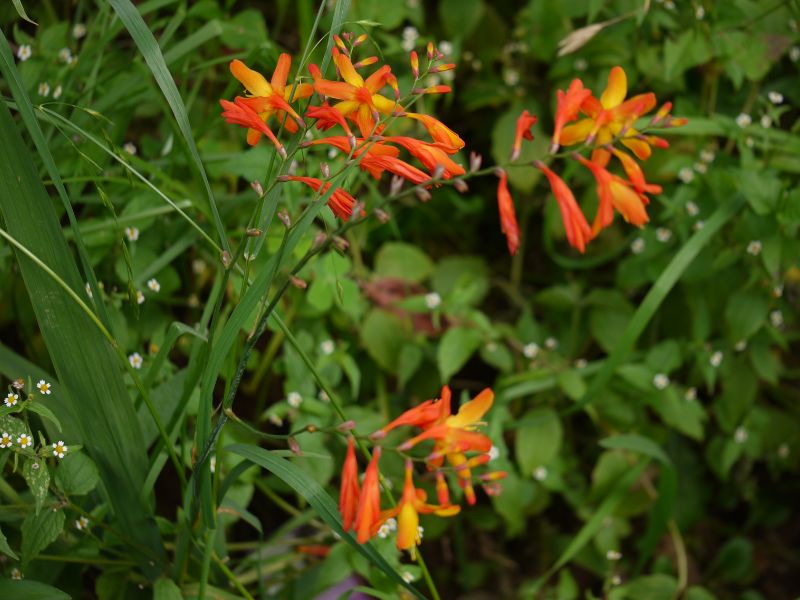
These brightly colored flowers add a vibrant flair to beds, borders, islands, and naturalized drifts where the attractive vertical foliage adds interest even when the plants are not in flower.
They also grow well in containers, patio planters, and window boxes, and they’re a must-have for cutting gardens.
Mass planting is the best way to get a big display of color, and to really make their bright colors pop, place crocosmia in front of rows of dark conifers, fences, or walls.
IV. Types of Crocosmia
- ‘Lucifer’ is a blood-red variety developed in 1966. It is the most popular and hardiest crocosmia variety in the trade, surviving winters in zone 5.
- ‘Bressingham Beacon’ has bi-color orange and yellow flowers but isn’t reliably hardy in USDA hardiness zones 5 and 6.
- ‘Citronella’ has cheerful lemon-yellow blooms.
Find Where to Buy the Best Coppertip (Crocosmia)

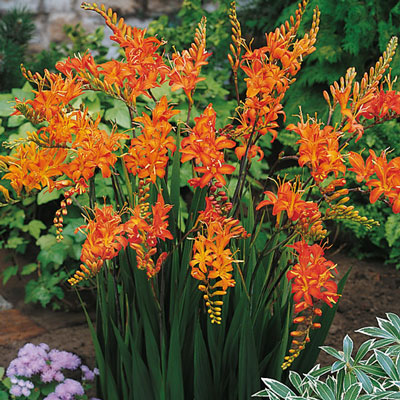


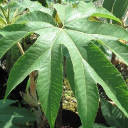
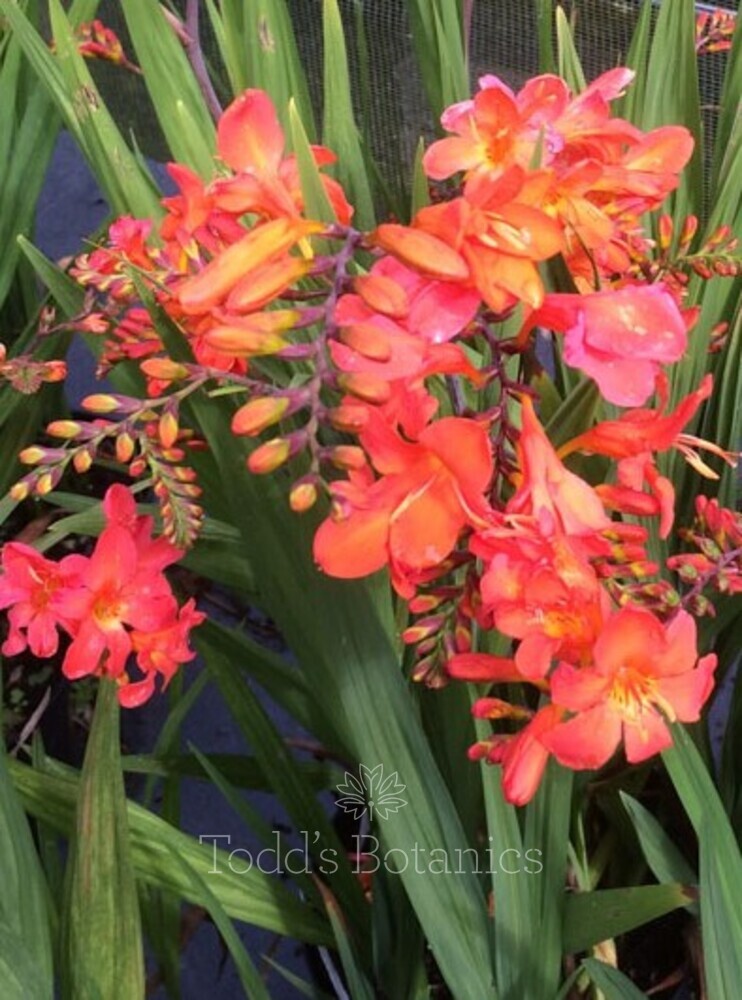

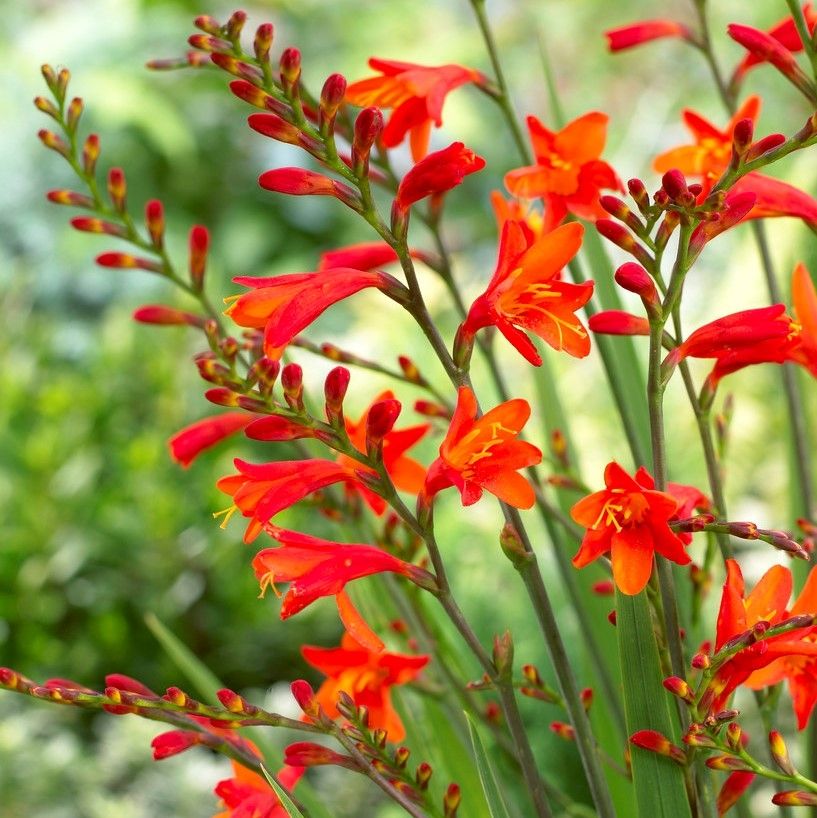








Leave a Reply